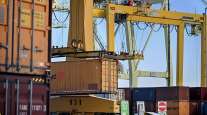Fleets Likely to Report Small 2Q Gains Despite Sluggish Economic Growth
This story appears in the July 15 print edition of Transport Topics.
Second-quarter profits will show only limited improvement for publicly traded fleets, due to lackluster freight volumes in a slow-growing economy, according to analyst estimates and reports.
“Second-quarter 2013 freight trends can be described as mixed,” Robert W. Baird & Co. analyst Benjamin Hartford said. “Overall growth rates [industrial and retail] continue to decelerate.”
As a group, 15 truckload carriers are expected to report a meager 3% increase in combined profits, based on a Transport Topics review of analyst surveys by Bloomberg News. Revenue also is expected to change little, totaling more than $5.3 billion for the period. Earnings reports are expected to begin rolling in this week from fleets such as Werner Enterprises Inc.
Among large fleets, earnings at J.B. Hunt Transport Services Inc. are expected to rise 10% to nearly $89 million above the 2012 second quarter, and Swift Transportation’s profits could climb about 7% to $41 million. Lower earnings are forecast for Landstar System Inc. and Werner, along with several smaller carriers.
Expectations for the less-than-truckload business are higher, with better results forecast for five of seven carriers.
Prospective gainers include Old Dominion Freight Line Inc., whose net income is expected to rise 15% to top $55 million, while Saia Inc.’s earnings are pegged at almost $9 million, a 12% improvement. Arkansas Best Corp. is expected to earn $5 million, and YRC Worldwide Inc.’s loss is expected to narrow to about $6 million from more than $20 million.
On the downside, Con-way Inc.’s net income is expected to slide about 10%, and Vitran Corp.’s losses are expected to mount.
“While freight demand is not yet robust, LTL carriers continue to be firm on pricing,” analyst Jason Seidl wrote in a report from Cowen Securities. “This is a continuation of a concerted effort by key players in the sector over the past couple of years to boost yields and improve margins.”
“With the macro environment improving, and the housing recovery showing no sign of slowing down, the LTL industry is well-positioned to take on more tonnage at attractive rates in the longer term,” Seidl wrote.
Roadrunner Transportation Systems Inc., whose revenue is about equally divided between LTL and truckload freight, is projected to raise net income more than 30% to nearly $12 million.
Results for the other two publicly traded freight companies — UPS Inc. and Ryder System Inc. — also are expected to be better. Net income should improve about 3% at UPS to $1.15 billion, based on estimates, while Ryder’s earnings are expected to top $63 million, up about 25%.
The overall industry results reflect tepid economic conditions and a lackluster market, with gross domestic product increasing less than 2% in the quarter.
Hartford said East and West Coast freight markets were soft last month, but markets in the Midwest and South were “firm” because of the ongoing recovery in the housing and auto markets.
Other analyst comments reinforced the slow-growth theme.
“Given a sluggish economy, the truckload supply dynamic remained roughly in balance last quarter,” Deutsche Bank analyst Justin Yagerman said in a July 10 report.
Industry statistics from American Trucking Associations reinforced the low expectations among dry van, general commodities and refrigerated freight carriers that account for 21 of the 23 publicly traded fleets. ATA data show the truckload market volume has grown less than 1%, while less-than-truckload carriers have added barely 1% more freight.
The slow growth in the truckload and LTL sectors is in contrast to the 4.5% growth over last year in American Trucking Associations’ tonnage index during the first five months of 2013.
That index has been propelled to a record by tank truck shipments. Among publicly traded fleets, only Quality Distribution and Patriot Transportation participate in the tank sector. Patriot’s earnings in the period, its fiscal third quarter, are projected to climb 14%. Quality’s profit is expected to fall 7%.
“Truckload demand is lackluster, and our belief is that a real capacity crunch may still be several months away,” Seidl said.
His comment was a reference to an expected tightening of capacity resulting from less driver availability following the July 1 changes to the hours-of-service rule.
Arthur Hatfield, a Raymond James & Co. analyst, agreed that HOS could have a pronounced long-term effect on the truckload market, potentially driving up rates and profits as capacity tightens and fleets gain leverage with shippers. Truckload rates have risen only 2% this year over 2012, he said in his July 8 report.
Logistics earnings also are expected to improve modestly, with higher profits at C.H. Robinson Worldwide, Hub Group, Expeditors International and Pacer International. Earnings are expected to decline at XPO Logistics.


